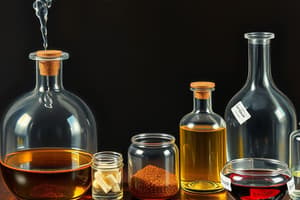Podcast
Questions and Answers
Matter is defined as anything that has weight and occupies space.
Matter is defined as anything that has weight and occupies space.
False (B)
Elements are pure substances that can be separated into simpler substances by chemical means.
Elements are pure substances that can be separated into simpler substances by chemical means.
False (B)
A compound consists of two or more elements combined in a specific ratio.
A compound consists of two or more elements combined in a specific ratio.
True (A)
Sugar has the chemical formula C6H12O6, which indicates it is a pure element.
Sugar has the chemical formula C6H12O6, which indicates it is a pure element.
Heterogeneous mixtures have components that are uniformly distributed.
Heterogeneous mixtures have components that are uniformly distributed.
An example of a homogeneous mixture is saltwater.
An example of a homogeneous mixture is saltwater.
Mixtures can only consist of two substances.
Mixtures can only consist of two substances.
Compounds can be separated into their elements by physical methods.
Compounds can be separated into their elements by physical methods.
In a heterogeneous mixture, the proportions of components can vary.
In a heterogeneous mixture, the proportions of components can vary.
Flashcards are hidden until you start studying
Study Notes
Composition of Matter
- Matter is defined as anything that has mass and occupies space, encompassing all non-energy forms.
- Matter exists as either a pure substance or a mixture of substances.
Pure Substances
- A pure substance features a fixed composition that cannot be separated by physical means.
- Two types of pure substances:
- Elements: Composed of only one type of atom; examples include gold, helium, and aluminum.
- Compounds: Formed when two or more elements combine in a fixed ratio.
Compounds
- A compound consists of atoms from two or more elements combined in a specific proportion.
- For instance, water is a compound made up of two hydrogen atoms and one oxygen atom (H2O).
- Sugar has the chemical formula C6H12O6, indicating six carbon atoms, twelve hydrogen atoms, and six oxygen atoms.
Mixtures
- Mixtures differ from pure substances as they comprise two or more substances that can be separated by physical methods.
- Mixtures do not maintain a consistent proportion of their components; for example, in fruit salad, the amounts of grapes, pineapple, and strawberries can vary.
Types of Mixtures
- Heterogeneous Mixtures: Components can be easily distinguished and visually identified. Examples include pizza, trail mix, and granite.
- Homogeneous Mixtures: Substances are evenly blended and not easily separable. Examples include soda, vinegar, and saltwater.
- In homogeneous mixtures, all components are uniformly distributed. For example, in saltwater, the salt dissolves completely, creating a uniform solution.
Composition of Matter
- Matter is any entity that possesses mass and occupies physical space.
- Exists as pure substances or mixtures, distinguishing non-energy forms.
Pure Substances
- Characterized by a fixed composition that cannot be separated through physical processes.
- Two main categories of pure substances:
- Elements: Made up of a single kind of atom; examples include gold (Au), helium (He), and aluminum (Al).
- Compounds: Composed of two or more elements joined in a specific ratio.
Compounds
- A compound consists of atoms from multiple elements bonded in precise proportions.
- Example of a compound: Water (H2O) is formed by two hydrogen atoms and one oxygen atom.
- Sugar (C6H12O6) comprises six carbon atoms, twelve hydrogen atoms, and six oxygen atoms.
Mixtures
- Comprise two or more substances that can be physically separated, unlike pure substances.
- The components in mixtures do not have a fixed ratio and can vary in quantity; for instance, in fruit salad, the ratio of grapes to pineapple can change.
Types of Mixtures
- Heterogeneous Mixtures: Constituents can be individually identified and easily separated; examples include pizza, trail mix, and granite.
- Homogeneous Mixtures: Components are uniformly mixed and difficult to distinguish; examples include soda, vinegar, and saltwater.
- In homogeneous mixtures, all components are evenly distributed, as seen in saltwater where the salt fully dissolves.
Studying That Suits You
Use AI to generate personalized quizzes and flashcards to suit your learning preferences.



